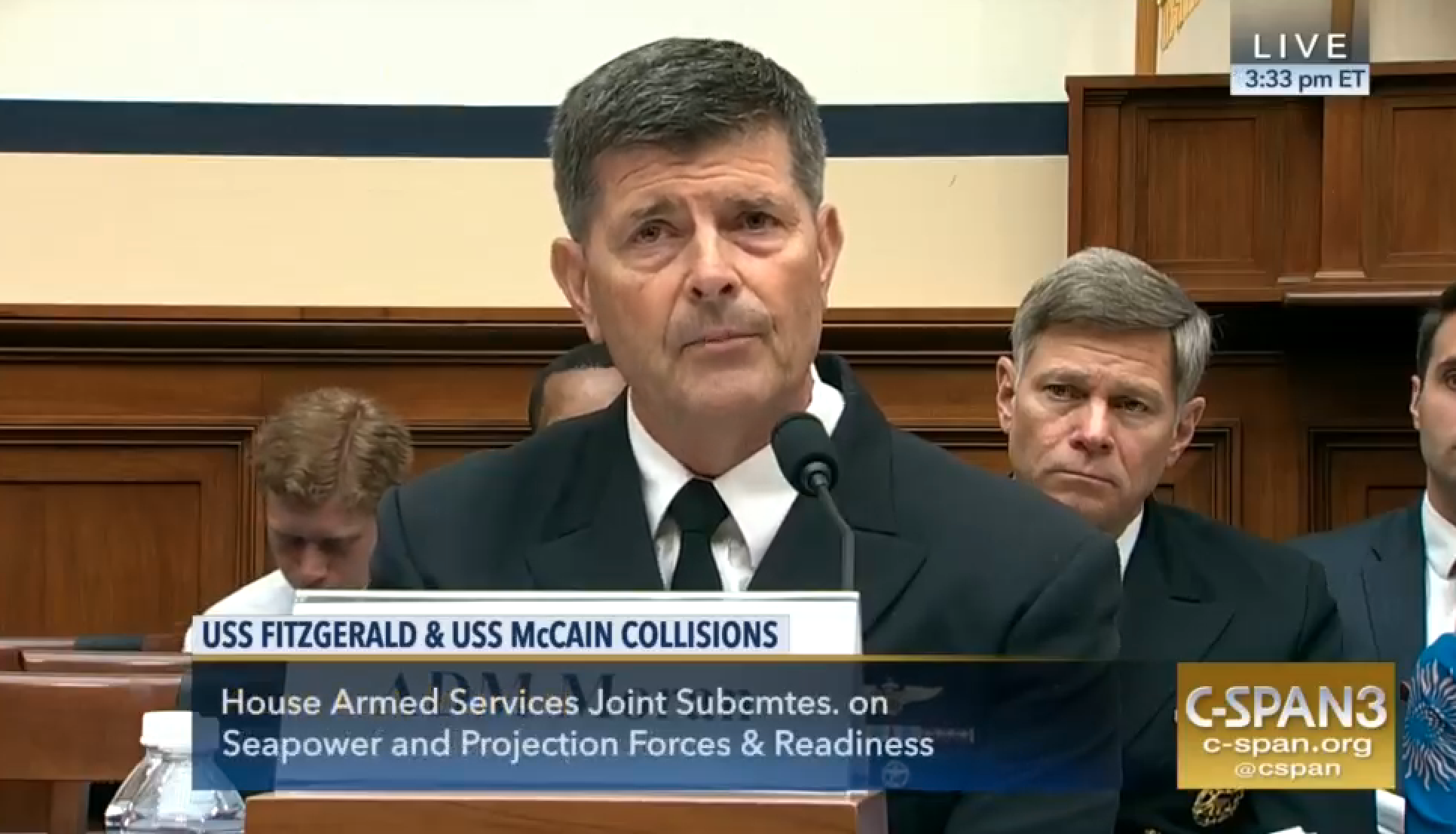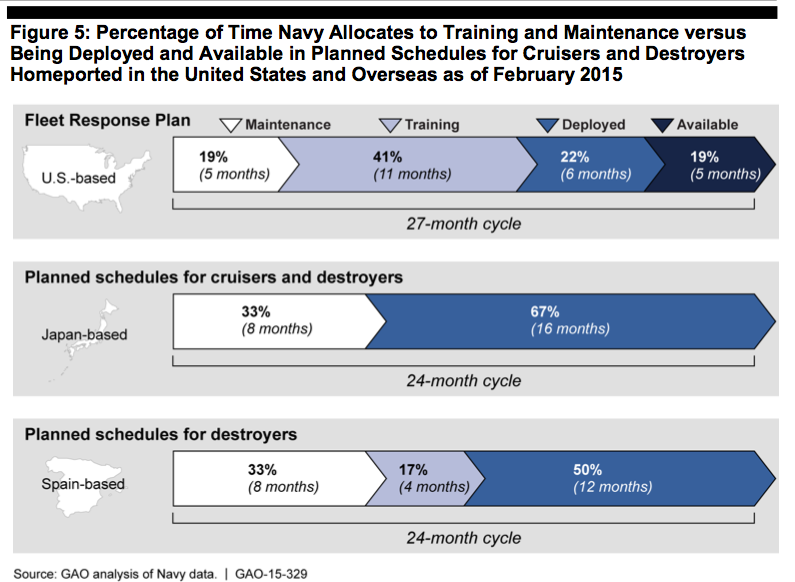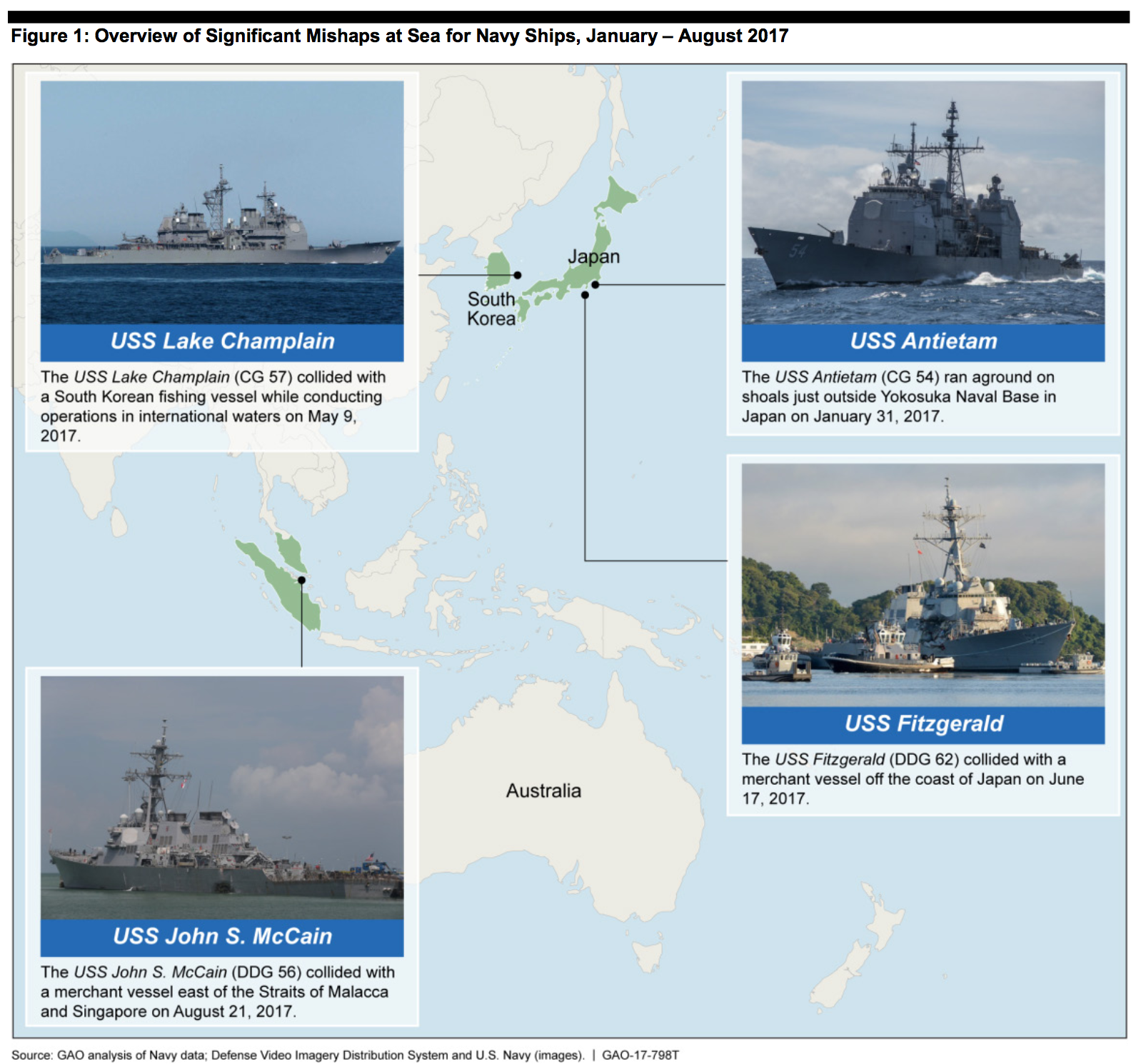
CAPITOL HILL – The Navy’s second in command told Congress that he had always assumed the service’s forces in Japan were among the services best due to their constant operational tempo. That changed after a quartet of surface ships suffered a chain of incidents that resulted in the death of 17 sailors and hundreds of millions of dollars in damages.
“I have had made the assumption for many, many years that our forward deployed forces in Japan were the most proficient, well-trained, most experienced force we have because they were operating all the time,” Moran told a Thursday joint hearing before the House Armed Services readiness and seapower and projection forces subcommittees.
“It was the wrong assumption.”
Understanding the limits and the strain of the Navy’s forward deployed naval forces was key to the hearing on the underlying issues that led to the collisions of USS John S. McCain (DDG-56) and USS Fitzgerald (DDG-62) with merchant ships in August and in June.
Moran, the Navy’s director of surface warfare Rear Adm. Ron Boxall and Government Accountability Office director of defense readiness issues John Pendleton outlined a force in Japan that was in high operational demand with less and less time for training and maintenance.
GAO’s Pendleton’s written testimony, based on the Navy’s own data, highlighted an increased trend in maintenance waivers and lapsed training certifications in basic warfare areas like seamanship.
“We found that, at the time of our 2015 review, there were no dedicated training periods built into the operational schedules of the cruisers, destroyers, and amphibious ships homeported in Yokosuka and Sasebo, Japan,” Pendleton said. “As a result, these crews did not have all of their needed training and certifications.”
As of June 2017, 37 percent of the warfare certifications for cruiser and destroyer crews homeported in Japan had expired, and over two-thirds of the expired certifications—including mobility-seamanship and air warfare—had been expired for five months or more

“There were specific areas that were higher than 37 percent and one of those was seamanship. Eight of the 11 ships had expired certification for seamanship,” he told the panel
“This represents more than a fivefold increase in the percentage of expired warfare certifications for these ships since our May 2015 report.”
Both the Fitzgerald and McCain had expired certifications, but Pendleton wouldn’t detail the precise certifications that were out of date.
Moran and Boxall didn’t quibble with the GAO’s assessment of the FDNF forces which Pendleton said had grown worse since a 2015 report concluded that the service’s, “overseas-homeported ships have had lower material condition since 2012 and experienced a worsening trend in overall ship readiness when compared to U.S.- homeported ships.”
In particular, Moran singled out the trend for surface ships operating in Western Pacific to routinely ask for waivers to operate without otherwise required certifications and maintenance. The risk assessment management plan, or RAMP, allows surface ships to operate if the commander submits a plan on how he or she will mitigate the certification issue within a given time frame.

“The trend in the number that we’re asking for waivers is increasing at an alarming rate and it should give us all pause in how hard we’re driving the crew in 7th Fleet, changing schedules, delayed maintenance and additional missions they’ve been asked to perform,” Moran said.
He told the panel that funding reductions and consistent uncertainty over Congressional budget approvals are especially damaging. The uncertainties prevent the Navy from taking steps necessary to mitigate the burden on ships and crews caused by the high operational demand.
Moran credits the additional $2.8 billion in funding Congress approved for the Navy in Fiscal Year 2017 as helping the Navy dig out from the readiness holes that resulted from repeated Continuing Resolutions and the Budget Control Act mandated spending caps.
For FY 2018, Moran stated the Navy increased its funding request by $3.4 billion to address fleet readiness needs.

In the shorter term, Moran and Boxall said the results of the new review led by U.S. Fleet Forces commander Adm. Phil Davidson would help solve operational problems in the Western Pacific.
“A key question for Adm. Davidson’s teams to assess: How much operational tempo in places like Japan, or places where we have forward forces, reaches a point where we can’t do the maintenance and the training and have the amount of time left to do the operations? ,” Moran told the panel.
“The key part is, do we have the right training in place for commanding officers. Are they getting enough of what they should have to operate in waters that have become highly congested and contested in that region? It’s a lot busier than it was eight years ago. We need to review that. We need to review the training. We need to review the career paths for our officers and our junior officers and we need to make sure they understand they have the right planning models in place and the GAO calls that out in their report.”
As to the specific chain of events that led to the collisions of Fitzgerald and McCain, Moran indicated to the panel the public results would be limited due to the privileged status of the dual purposed investigations. The type of investigations designed to help the U.S. limit liability. However, the Navy used early results of the dual-purpose investigation into the Fitzgerald collision to remove the ship’s leadership tried and contributed to the removal of U.S. 7th Fleet commander, Vice Adm. Joseph Aucoin.
Still, seapower subcommittee chair Rep. Rob Wittman (R-Va.) told USNI News that his committee was set to ask more questions on how the forward forces may be stretched too thin.
“I’m interested to learn the breakdown as we’ve seen… in the timelines on what happened on the Fitzgerald and what will come out on the McCain,” Wittman said.
“What I think is going to be of interest to the committee is what happened operationally in the decision making with the leadership in the decision making aboard those ships and what the Navy is going to do to respond to that.”





